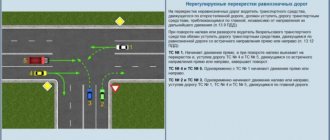| Question | Answer |
| What groups of child car seats are there? | * group 0 - designed for a child weighing 0-10 kg; * group 0+ - suitable for a child weighing less than 13 kg; * group I - suitable for children weighing 9-18 kg; * group II - suitable for a child weighing 15-25 kg; * group III - chairs are designed for children weighing 22-36 kg. According to traffic regulations, it is prohibited to use a car seat that does not correspond to the weight parameters of the child. |
| What are the requirements for transporting children under 12 years of age? | Traveling in a car for a child under 12 years of age is permitted only when using a car seat that matches the weight and height of the child. Instead of a seat, you can use other means to help secure the child and appropriate vehicle designs. If a child under 12 years of age is placed in the front seat of a car, he must be secured only with a child car seat. |
| What are the rules for transporting children in a car seat in 2020? | * according to traffic regulations, a child must be transported in a car seat appropriate for his weight and height; * transporting a child in a restraint system is permitted both in the rear and front seats of the car; * if a child is under 12 years old, he can only be placed in the front seat of the car in a car seat (pillows, boosters, and adapters are prohibited). |
| What fine must I pay for incorrectly transporting a child without a seat in 2020? | * 25 thousand rubles. for officials; * 3 thousand rubles. for the driver; * 100 thousand rubles. for legal entities. |
| Is it possible to get a discount on a fine? | Yes, if you pay the fine within 20 days after the decision is issued. |
Passenger safety is an important responsibility of the driver, especially if there is a child in the car.
The rules for transporting children determine what requirements the technical equipment of the car must meet. Their implementation can save the baby’s life in the event of a traffic accident.
According to statistics, the highest rates of child mortality in road accidents occur in cases where minor passengers were in the car in the arms of adults.
Why is a child car seat created?
For this reason, new rules for transporting children came into force in July 2020. However, like any legislative document, the amendments are stated clearly, but dryly, requiring comments and explanations of individual points regarding how to transport children in a car in a new way, up to what age a child should ride in a car seat, how and where a restraint system should be installed and much more.
A modern car is not equipped with a single element designed to ensure safety when transporting children. Standard car seat belts, designed for people whose height is higher than 135 cm, are not only structurally inappropriate for the physique of a child under 12 years old, but can also cause serious injury or death in an accident.
In a collision, children slip under a loose belt and receive varying degrees of injuries from contact with vehicle parts. Older children suffer neck injuries from the diagonal strap of a seat belt or damage to the abdominal organs from a belt placed across the abdomen. In case of side collisions and car rollovers, children fastened with regular seat belts are absolutely defenseless.
In addition, car seats do not anatomically correspond to a child’s body. Unnatural and uncomfortable baby positions can lead to the development of various diseases over time. If children remain in this position for a long time, they experience difficulty breathing, circulatory and digestive disorders, as well as the formation of incorrect posture and the development of pathological conditions of an immature spine.
A child car seat increases a passenger's chance of surviving a car accident by more than 80%. This has been proven by crash tests in near-emergency conditions. During a collision of a car with an obstacle at a speed of 50 - 60 km/h, an unbelted dummy sitting in the back seat falls sharply forward and is hit by the back of the seat in front, then it is thrown back. Often the doll breaks through the glass and flies several meters away from the car.
Often, older children sit their children on their knees in front of them and fasten them with the same seat belt. Test tests show in such situations a different development of events, no less terrifying in its destructive power. When a car collides, the adult passenger is thrown sharply forward, thereby greatly increasing the force with which the child dummy hits the back of the front seat. Even a strong man will not be able to hold the baby in his hands, but will crush him with his weight, causing injuries of varying severity. This method of transporting children is recognized as the most dangerous.
The road is unpredictable, and even experienced motorists are not immune to dangerous situations. A child car seat is designed to ensure the safety of a small person, holding him securely and protecting him from injury in an accident.
Alternative to a car seat
In addition to special restraint devices, motorists can use other means not prohibited by traffic regulations. After all, not every parent has the free funds to buy a much-needed item. Therefore, you can build a “chair” yourself; for this you will need belts or other holding elements that will secure the pillow or folded blanket, the pillow itself (blanket) and belts that will hold the baby in this pillow.
In addition, there are several manufacturers of car seats on the modern market, among which the domestic brand “FEST” is in the lowest price category, but meets all the requirements of traffic regulations. This device is suitable for babies whose weight ranges from 9 to 36 kg. Therefore, if you rarely transport children in your car and do not want to receive a fine from the traffic police, then this option is the most optimal for you.
Sometimes traffic police officers, due to their lack of qualifications, insist that a child can only be transported in a car while sitting in a special child car seat. Therefore, situations sometimes occur when transporting children in a homemade “chair” is regarded as a violation of traffic rules, and the driver is given a fine. But such incidents can then be clarified in court, since the court often sides with the car owner and removes penalties.
Rules for transporting children in a car in 2020
Changes in traffic rules that came into force on July 12, 2020 and determine the methods of transporting children in a car cannot be definitely called strict. Some previously popular products are prohibited from use by the new rules. Frameless seats, adapters, pillows or books used as pads are considered unsafe and are excluded from the list of permitted car accessories.
Along with such strictness, the new requirements provide permission to transport children over 7 years of age without the use of car seats. Let us remind you that the regulations in force until 2020 regulated the mandatory use of car seats until the child reaches 12 years of age.
Today, legislators have approved two children's age categories for the transportation of which car seats must be used:
- up to 7 years;
- from 7 to 12 years.
Children over 7 but under 11 years of age are allowed to travel without a car seat, but wearing regular car seat belts.
The old requirements remained unchanged regarding the transportation of children 7 - 11 years old in the front passenger seat. In this situation, children should definitely only be in a restraint system. It is worth mentioning that the upper age limit is determined by the new edition of the traffic rules “up to 11 years (inclusive).” It follows from this that a child who has reached the age of 11 must continue to travel in a car seat in the front passenger seat. A teenager who is 12 years of age or older has the right to ride as an adult passenger in any row of seats without a special restraint device.
The rules regarding motorcycles have not changed. Children under 12 years of age are prohibited from being transported on the back seat of a motorcycle. The only solution in these circumstances is to carry the small person on the side of a motorcycle trailer.
Carrying children in the front seat
Parents often find it difficult to choose a specific restraint system. Unfortunately, you can’t just go to the store and buy the first thing you come across that suits your weight and height. Much of what was previously allowed is now prohibited, but is still on sale.
The law does not shed light on many nuances. Inspectors are guided by unknown instructions. What should the consumer do? What can and cannot be used? Is it possible to install a booster seat or a frameless seat in a car, or do you now only need something expensive with a frame?
Is the frameless chair part of the adapter group or is it classified as a chair? There is no clear answer. The same problem applies to boosters, categories 2-3. For young children they may be considered unsuitable. However, unclear wording can confuse drivers.
The conclusion is simple: if your financial capabilities allow, you need to purchase a high-quality chair with a frame. If finances are limited, then be guided by your capabilities and be an extremely careful driver if there are children in the car.
But you won’t be able to get by with a very cheap option, like a fabric addition to a belt. The law directly prohibits this. And here there can be no dual interpretation. Transporting children using the adapter is prohibited.
The restraint system, according to traffic regulations, must comply with the technical regulations of the Customs Union (CU). This document is consistent with a similar European one, so high-quality foreign models comply with the requirements of Russian legislation.
Usually cradles are used for babies up to six months. The chair is best suited for children under 3 years old. And starting from the age of 3, you can already use a booster or chair. Thus, only a cradle or a chair is suitable for the smallest ones. Simplified solutions are not applicable to them.
Classification of child car seats
Today, the child restraint market offers a huge range of car seats, differing in size, characteristics, design and other parameters.
In Russia, a European classification has been adopted, which regulates 5 categories of car seats, correlated with the age and weight of small passengers:
- “0”: from birth to 1 year, up to 10 kg. The car accessory is a cradle. The newborn is placed in it in a supine position and secured with a soft belt. The design is equipped with fastening elements, internal seat belts and protection for the baby's head. The car seat is attached to the seat using standard belts or the Isofix system sideways in the direction of travel, that is, along the rear row of seats. The products demonstrate a low level of reliability during testing, so transporting infants in an infant carrier requires increased attention and supervision from adults. It is much safer to move a small passenger in a car seat of the next group “0+”.
- “0+”: from birth to one and a half years, up to 13 kg. The position of the child in such a chair is “reclining”. The product is highly versatile compared to a cradle and is used as a carrier, high chair or swing for a baby. The carrier can be installed on a special chassis and used as a stroller for walking your baby. This category of restraint systems is highly reliable, firmly fixing the body. The “0+” car seat is attached to any passenger seat facing the direction of travel. It is possible to install the car accessory on the front passenger seat when the airbag is disabled.
- “1”: 1 - 4 years, 9 - 18 kg. Externally, the product resembles a soap dish installed in a power frame. This makes it possible to choose a different angle of inclination of the back of the structure for the baby’s wakefulness and sleep. The baby is firmly held in the chair with a five-point harness. The product is mounted on one of the rear seats exclusively in the direction of travel.
- “2”: 3 – 7 years, 15 – 25 kg. The device has the functions of extending the backrest and the ability to switch from internal straps to external, standard car belts. The device helps the child transition and adapt to a regular car seat. Installation of the accessory is possible only on the rear seats in the direction of travel of the car.
- “3”: up to 130 cm, up to 36 kg. The product does not come with its own belts: the child is secured in it with regular car seat belts. Due to its design features, this category of car seats has a locking mechanism for the top strap of the seat belt and a function for removing the backrest. The older child continues to use the safety accessory, but in the form of a booster. The design is attached exclusively to the rear sofa, secured with a car belt and does not have a “reclining” or “lying” position.
In addition to the categories described above, there are types of chairs that are suitable in design for several age groups of children.
These are transformable chairs that have become popular, combining two or three categories in one. Such devices have height-adjustable internal straps, removable side pads, headrest and backrest. Economically, it is profitable to purchase car accessories for growth, but from the standpoint of convenience and reliability, this option is not the best. When choosing a car seat, it is advisable to rely on the toddler’s feelings: he should be comfortable. This condition is even more important if parents often and for a long time move the baby in the car.
How to transport a newborn in a car according to the rules
Infants (up to six months old) ride in a car while in a cradle .
There are latches inside it that securely hold the child. The cradle itself is attached to the seat belts in the rear seat. The position in this case is perpendicular to the direction of movement of the car. From six months to a year, it is recommended to carry babies in a special chair , where they have the opportunity to both lie and sit. Such child restraints can even be placed in the front seat - if the mother is driving, the child will be calmer there. Moreover, the seat is installed so that the child can see either the front windshield or the rear window. The second option is preferable, because causes less anxiety for the baby - he sees his mother’s (or father’s) face. Parents don't have to turn their heads to look at him either.
Important! When placing a restraint device in front, it is necessary to disable the airbag mechanism - in an emergency, it can cause great harm to the baby and seriously injure him.
Features of transporting children under 7 years old
Children under 7 years of age must be transported exclusively in a special car seat. It does not matter where it is installed: in front or behind, and what kind of vehicle is used - passenger cars or trucks.
However, there are several nuances that parents should be aware of in order to avoid injury to their child:
- babies under 1 year old should not be transported facing forward - at this age the neck muscles are still weak, and even slight braking can injure the child’s cervical spine;
- the front seat can be used to move children only if the airbag is absent or disabled - it is not recommended to disable the system yourself; it is better to contact a service center for this service;
- It is forbidden to place pillows, books and other available materials under a toddler wearing a seat belt - during emergency braking, an unsecured object slips out from under the body, dragging his lower body forward, and the seat belt ends up at the level of the baby’s neck and can cause him incompatible injuries with life;
- during long trips, you should take breaks of 15 - 20 minutes every 1.5 - 2 hours and remove the baby from the cradle or car seat - older children can be given the opportunity to walk and warm up;
- when calling a taxi, parents should warn the operator that a child will be traveling in the car and indicate his age - a reliable company will figure it out and send a car equipped with the appropriate child safety accessory;
- toys that a child uses to entertain himself on the road should be soft and light - heavy or sharp objects can cause irreparable harm to the child during emergency braking or an accident.
Safe models of car seats must have a certificate and a sticker with installation rules. The product must correspond to the parameters of the passenger and be secured in the passenger compartment according to the instructions, using car seat belts or an approved Isofix system.
Ages from 7 to 11 years: transportation nuances
Children 7 - 11 years old inclusive are allowed to be transported without a special child restraint system in the back seat of a passenger car and in the cabin of a truck. In this situation, it is mandatory to secure the body with a regular seat belt. The amendment to the law allows parents not to spend money on a larger accessory. This is aggravated by the fact that some children are quite large by nature, and it is not possible to seat them in a standard product that matches their parameters and age.
However, when circumstances force a schoolchild under 12 years of age to travel in the front passenger seat, then by law you should acquire a car seat designed for the passenger’s height and weight. In the absence of a suitable car accessory, or when the appearance parameters do not allow him to fit in a child car seat, he has the opportunity to go to the back seat and ride there with a standard seat belt fastened.
In short, with the introduction of new standards, parents have the opportunity to independently determine whether a child between 7 and 11 years old needs a car seat or not. Regardless of the passenger’s age, traffic rules allow people taller than 150 cm or weighing more than 36 kg to travel without a special car seat.
Despite the relaxations in the legislation, experts strongly recommend the use of car seats and boosters for transporting children 7 - 11 years old. This measure will make the trip safe, preserving the health of children and the nerves of parents.
Transportation of children from 12 years old
Schoolchildren in this category can drive without the use of special restraints, except for standard seat belts.
A restrained teenager can be transported in any passenger seat of a car, both front and rear. When transporting a child over 12 years of age in the front seat of a car without a car seat, you should make sure that the airbag is in working order and activated. If a teenager 12 years of age or older has a fragile build and low weight, there is a high probability that he will slip under a loose seat belt during an accident. In this situation, parents independently determine the need for a child car seat until the child reaches parameters that allow him to drive without using restraints.
Law on the rules of transportation of children
The main regulatory act that established the standards for the transportation of children is RF PP N 1177. It outlines the requirements regarding:
- conditions for transporting children's groups and small numbers of children;
- transport that can be used with children;
- a driver who has the right to drive a vehicle and transport one or a group of children;
- an employee accompanying minors during the trip.
Naturally, persons under 18 years of age must travel in vehicles in the presence of adults. If we are talking about a large group, then the number of accompanying persons also increases.
Decree of the Government of the Russian Federation of December 17, 2013 No. 1177 “On approval of the Rules for the organized transportation of a group of children by buses”
Installing a child car seat
According to Western statistics, a high-quality child car seat saves life and health in an accident in 90% of cases. However, according to the same statistics, more than 80% of parents are irresponsible when it comes to securing restraints, that is, 8 out of 10 seats are not protected in an accident. Due to this, the high protection efficiency of even the safest model is rapidly reduced to zero.
You can maintain the safety parameters of the product by observing a number of requirements when installing and using it:
- The car seat should be installed strictly according to the manufacturer's instructions. Testing conducted by manufacturers is designed to make devices as safe as possible. Therefore, installation instructions should not be neglected, even if the process seems elementary.
- The safest place to install a car seat is the middle of the rear seat. The results of crash tests show that here the child is maximally protected from dangerous body dents and glass fragments in a side impact. In addition, the open area in front reduces the likelihood of the baby being pinned between the seats in a frontal collision or a strong rear impact. If the car is 7-seater, then the accessory must be installed on the second (not third!) row of car seats in the middle or on the outer seats of this row.
- The front seat for installation is usually used mainly by mothers who often travel alone with small children. It is convenient to give a bottle or toy to the baby sitting next to you without being distracted from the road. Such measures are not welcomed by law enforcement officers on the roads, since they certainly reduce the driver’s attentiveness and concentration. However, in exceptional cases and when the airbag is disabled, such installation of a car accessory is permissible.
- The child restraint system must stand firmly on the seat and be a stable structure. To do this, it should be fastened so that the play, that is, the displacement of the fastened seat when rocking, is no more than 2 - 3 cm. Otherwise, you will have to install the device again.
- Adult car seat models of categories 2, 3 and 2/3. In the absence of a passenger, when the vehicle is moving, they must be fastened with seat belts to avoid displacement and injury to the driver and other passengers in the event of forced sudden braking or an accident.
A little practical advice for those who leave their car overnight in an unguarded parking lot or parking lot: the car seat should be removed and taken home, or left in the trunk if its dimensions allow. This measure will protect the car from intrusion by uninvited guests.
Fine for incorrectly transporting children
The new edition of the traffic rules has tightened penalties for motorists who violate the requirements for transporting children.
For improperly transporting children in a car, the driver faces a fine of 3,000 rubles. The absence of fastening elements in the vehicle required for installation of the structure does not exempt you from liability. In addition, incorrect installation of a car seat is subject to a fine.
A person aged 7 years or older who is not wearing a car seat belt is subject to a fine of 3,000 rubles being imposed on the motorist.
Transporting a schoolchild under 12 years of age in the front seat without a child restraint device is punishable by a fine of 3,000 rubles.
The use of seat belt adapters, frameless seats and other devices prohibited by the Code of Traffic Regulations entails a fine of 3,000 rubles.
For taxi drivers who do not comply with traffic rules regarding the transportation of small passengers, a fine of up to 100,000 rubles is provided.
Adults who leave a child under 7 years of age alone in a car must pay 3,000 rubles to the state budget. At the same time, at the discretion of the inspector, the motorist can get off with a warning or a fine of 500 rubles, which may differ depending on the region. For example, in Moscow and St. Petersburg, the amount of monetary penalties can reach up to 2,500 rubles.
High penalties for violators are designed to attract the attention of motorists to the issue of correct transportation of children. Having placed a small passenger in his car, the driver is obliged to provide him with safe transportation, maximizing the child’s chances of surviving in the event of an accident.
General provisions
Dear readers! The article talks about typical ways to resolve legal issues, but each case is individual. If you want to find out how to solve your particular problem , contact a consultant:
8 (800) 700 95 53
APPLICATIONS AND CALLS ARE ACCEPTED 24/7 and 7 days a week.
It's fast and FREE !
Any failure to fulfill driving duties entails the application of sanctions in accordance with the instructions of Article 12.27 of the Code of Administrative Offences. If, due to the driver’s fault, an emergency situation occurs on the road, then an administrative measure is applied to him.
It is expressed in the imposition of a fine on the driver of the car. The amount of the fine is determined by the severity of the action committed or his inaction in certain situations.
What it is
The term “car” refers to a highly maneuverable, self-propelled technical transportation device equipped with an internal combustion engine. In addition to the engine, the car is equipped with a transmission, chassis, body, control system, electrical equipment and a service device.
Its main purpose is to perform certain functions, such as:
- Transportation of people.
- Transportation of goods.
All passenger cars of various makes and models are assigned category “B”. They are classified according to the type of engine or the method of transportation along communication routes in urban and rural conditions. And trucks are included in categories - “C”, “C1”.
If children are transported in a car, then a child restraint system must be used in the rear or front seat. The same applies to the truck cab.
Who falls under the category
The legislator has provided certain requirements for persons who wish to drive a car:
| Indicators | Description |
| Possession of Russian citizenship | — |
| Coming of age | what gives civil rights and responsibilities |
| Recognition of legal capacity | in accordance with the procedure established by the legislator |
| Carrying out registration | by place of residence or location |
| Passing a medical examination | in order to establish the suitability of the state of health to drive a car |
| Mastering theoretical knowledge and practical skills in driving a car of a certain category | — |
Persons with abnormalities in their body and mental state are not allowed to drive a car. The norm is provided for by the instructions of Federal Law No. 196-FZ. The circumstance forces drivers to undergo mandatory examination at a medical institution.
The definition of civil liability of drivers is given in the instructions of Chapter 59 of the Civil Code of the Russian Federation. It provides for measures to ensure the protection of the property interests of persons involved in road accidents. Its consequences are determined by the competent and coordinated behavior of drivers and victims, which include passengers and pedestrians.
Leaving in the car
This part was added to the rules for stopping and parking cars in July 2020, when the updated version of the traffic rules came into force. The point of the innovation is that while the vehicle is parked, a child under 7 years old should not be left in it without adult supervision. The fine for an offense is 500 rubles. At the same time, a situation with a child locked in a car may be interpreted by a police officer as a violation of the rules for transporting children. And this deviation from the norms automatically imposes a fine of 3,000 rubles on the driver.
Such penalties are caused by the increased frequency of cases of locking children in a car “for 5 minutes” and the tragedies that occur as a result of the carelessness of adults. The fact is that the air in a closed car quickly heats up, especially in the hot season, and a child’s prolonged stay in such a space can result in heat stroke for him.
Oddly enough, there is also a controversial point here: legislators do not provide for circumstances when a mother is forced to leave a child alone in the car in order, for example, to refuel the car and pay for gasoline. The new rules require a parent to take their child with them to the checkout counter. What efforts the mother will make if this happens in winter or there are several children under 7 years old in the car, only she knows. The law is the same for all situations and all motorists without exception.
The information from the traffic rules that a preschooler can only be left in a car with an adult citizen also provokes reflection. That is, when leaving the car, parents cannot leave the baby in the care of their 17-year-old son: adulthood in our country begins at 18 years of age.
This point is also important - having found a young child alone in a closed car, law enforcement officers can initiate a criminal case for leaving in danger. This is already an article for which a fine of 80,000 rubles and imprisonment for up to 1 year are provided. In addition, parents can get into trouble with government agencies, authorities for minors, as well as guardianship and trusteeship authorities.











